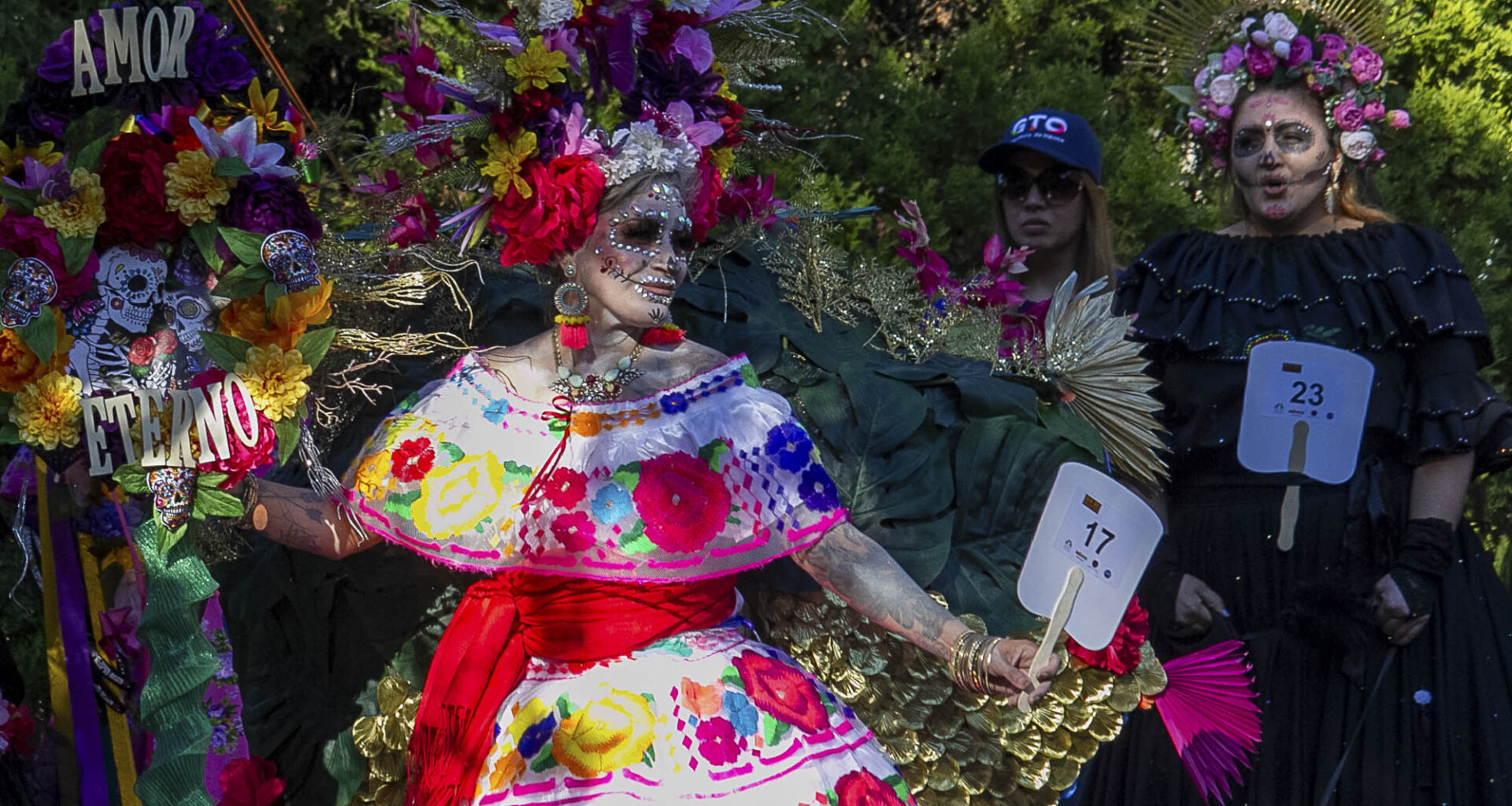Die de los Muertos returns the weekend of November 1-2, 2025. (Photos courtesy of the Historic Oakland Foundation)
Each November, Oakland Cemetery — one of Atlanta’s oldest landmarks — transforms into a community gathering space where families honor loved ones through the Mexican tradition of Día de los Muertos: the Day of the Dead.
Throughout the grounds, cultural touchstones bring the Latin American holiday to life. Brightly colored papel picado (perforated paper) flutters overhead, cempasúchil (marigolds) spill from every corner and in front of mausoleums, lavishly decorated ofrendas (altars) overflow with food, family photos and ornate skeletons. Now in its fourth year at Oakland, this free event has become one of Atlanta’s most beloved Day of the Dead celebrations.
In partnership with the Consulate General of Mexico, the Institute of Mexican Culture, and the Historic Oakland Foundation, Día de los Muertos has fostered an evolving dialogue about heritage and identity in one of the South’s most diverse cities. When asked how this partnership began, Marco Enríquez, of the Mexican Consulate’s Department of Cultural Promotion, points to a shared vision. “About four years ago, we started promoting the event with 70 kids making piñatas,” said Enríquez. “Since then, the event has been growing, and the cooperation between the three institutions has been developing in order to have one of the biggest events in the Southeast.”
Sandy White, the Historic Oakland Foundation’s director of adult programs and volunteers, echoed his sentiments. “Oakland is a place that by definition is where we honor the dead. We are a cemetery, but we are also a cemetery that is very active and known as a city park and a green space,” White explained. “It’s such a beautiful event because we already have all of these sort of permanent altars and monuments to the dead. Adding the beauty of the Mexican culture honors both specific parts of the Mexican-American community but also different parts of the city of Atlanta and other institutions that are unique to our city.”
The meaning behind the tradition
Día de los Muertos is one of Mexico’s most significant and symbolically rich holidays. Celebrated on November 1 and November 2, it’s a time to welcome back the souls of ancestors through food, music and celebration. According to tradition, the gates of heaven are opened at midnight on October 31, and the spirits of deceased children and adults can rejoin their families for a brief 24-hour reunion. The roots of Día de los Muertos, celebrated both in modern-day Mexico and around the world, date back approximately 3,000 years to the indigenous communities of pre-Columbian Mesoamerica.
Central to the holiday is the act of embracing and educating others about its cultural elements, each of which carries a deeper meaning. The centerpiece of the celebration, the ofrendas are created to honor the family members who have passed away. Even beloved family pets can be included, with portraits, favorite foods and toys placed on the altar. The marigold flowers, which symbolize the fragility of life, are believed to guide spirits to their families with their color and scent. The calaveras (skulls) are a reminder of the joyful coexistence between life and death and signify that the holiday is a festive celebration that embraces death as part of the human experience.
The skull’s historic usage in the holiday is significant. The tradition traces back to La Catrina, the satirical skeleton figure created by Mexican printmaker José Guadalupe Posada in the early 1900s. Since its origins as political art, it has become one of the most recognizable symbols of Día de los Muertos.
The festival at Oakland captures these historic and artistic layers beautifully. Families and groups can apply to build ofrendas, traditional folklórico dances and mariachi bands perform on stage and vendors sell authentic dishes such as tamales and elote alongside desserts such as conchas and flan.


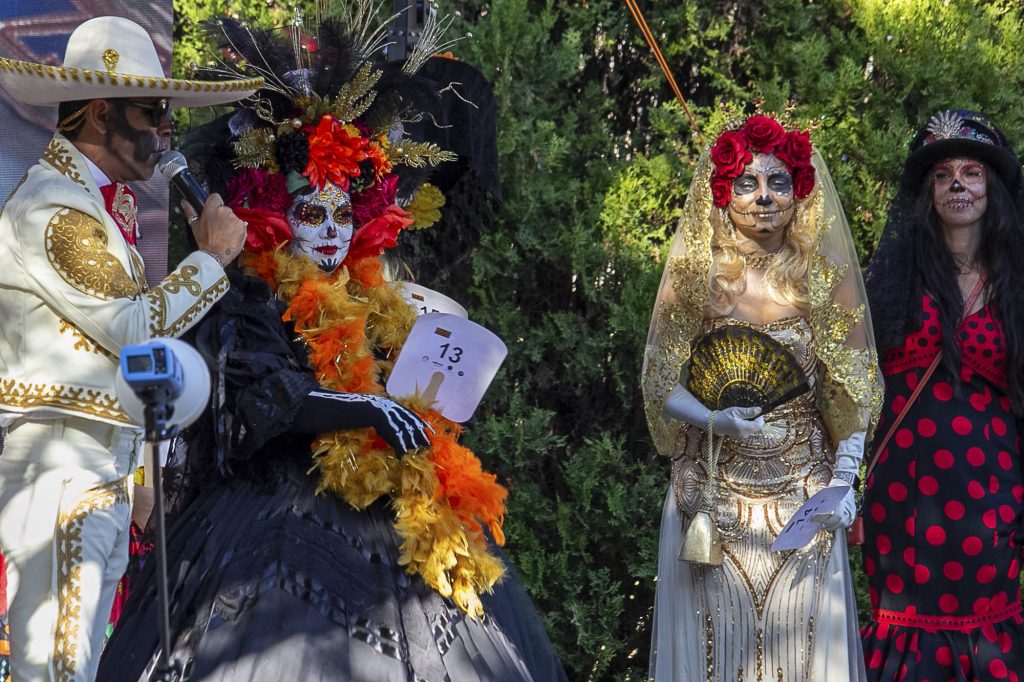



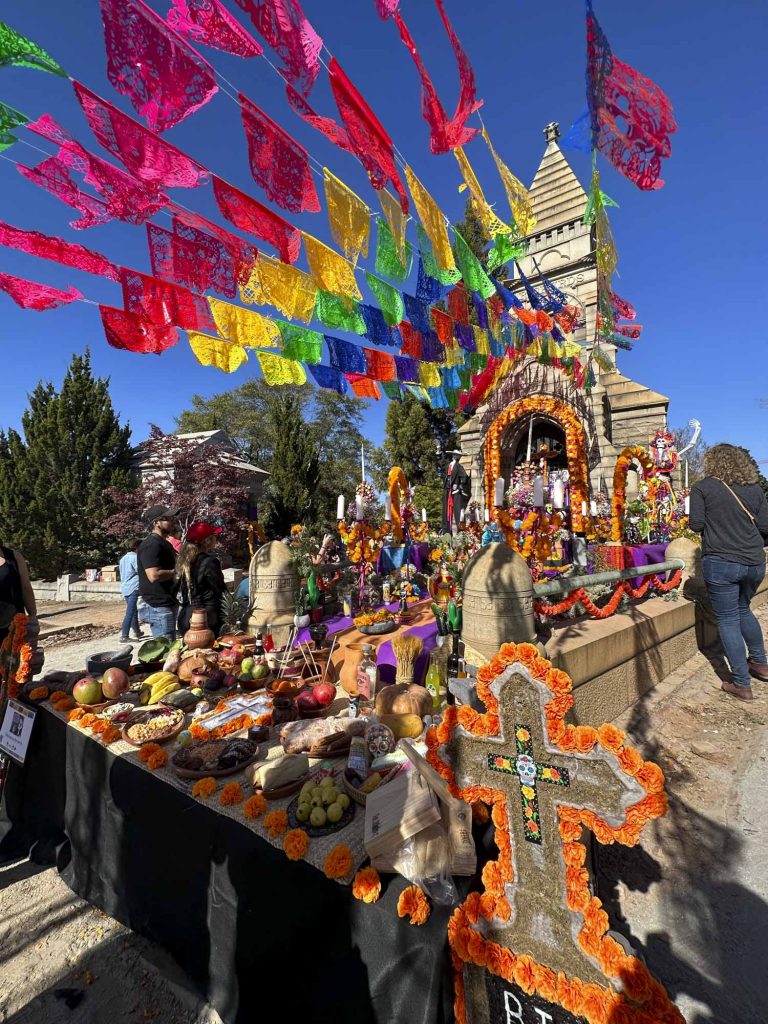
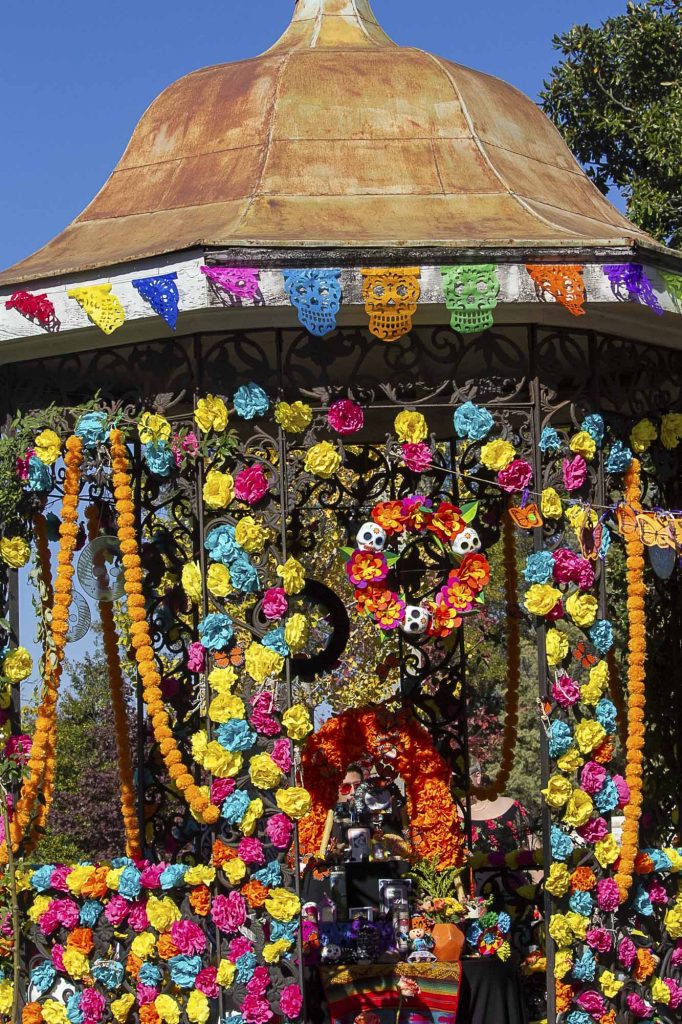
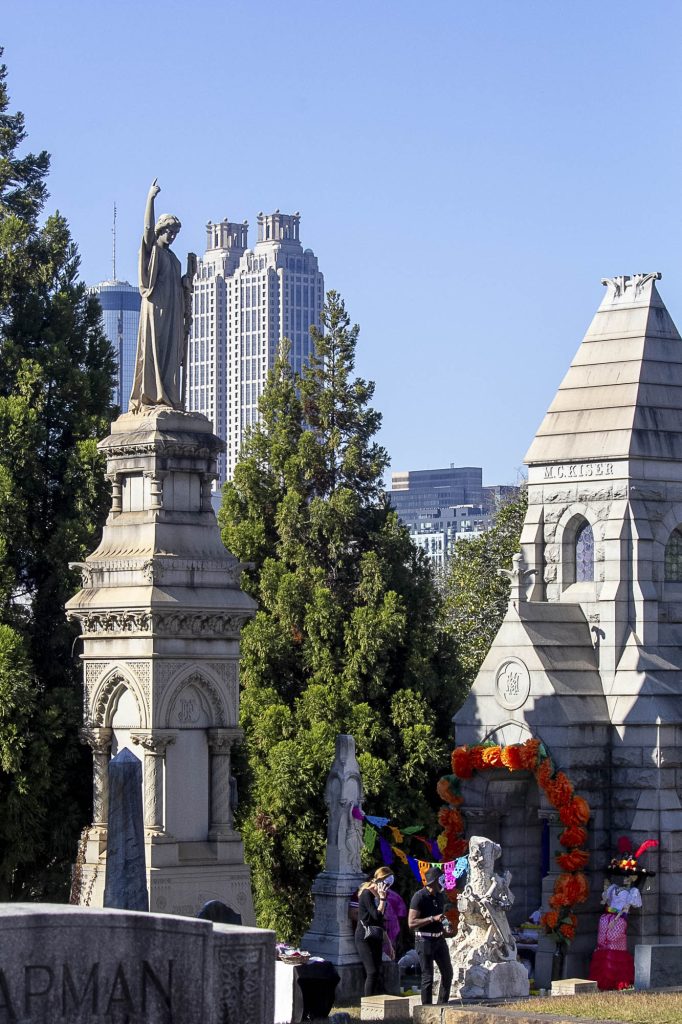
Photos from previous Día de los Muertos festivals at Oakland Cemetery. (Photos courtesy of Historic Oakland Foundation)
Keeping It authentic in a changing culture
As cultural holidays gain mainstream recognition across the United States — from Diwali and Lunar New Year to Kwanzaa — organizers must remain mindful of striking a balance between inclusion and authenticity. While all are welcome to attend the festival, there are parameters in place that keep the event’s programming purposeful and respectful in order to preserve Mexican culture. To participate in ofrenda creation, for example, participants must follow a seven-point checklist. “It’s amazing how creative people are. And every year they don’t stop to surprise us. But they must maintain these aspects because it’s also part of our identity,” Enríquez said.
Ultimately, it’s not about spectacle — it’s about substance. However, every culture mourns the dead in a different way. For some, Día de los Muertos may seem unconventional in how it honors the departed. While that’s acknowledged, Enríquez reiterated that this holiday focuses on celebrating death with joy and thankfulness.
White agreed that there is space for all cultures at Oakland Cemetery to be honored, but this day is specifically intended for Mexicans to feel seen and understood in their traditions. “At the cemetery, we talk about the Mexican tradition of three deaths: which is the death of your body so your physical form dies; the day that you are laid to rest, whether in the ground or cremated; and then the third death, popularized by Coco, of course, a movie about Dia de los Muertos, is the day that you’re last remembered. One of our goals year-round is that we never forget any of our 70,000 residents. And so by partnering with the Institute of Mexican Culture and the consulate, we are honoring our 70,000 residents and all of the family and friends of the people that we are working with.”
Growth, legacy and the spirit of Atlanta
From a modest cultural program to an annual event drawing thousands across the region, Día de los Muertos at Oakland continues to reflect the evolution both of the city and its people. Atlanta’s Latin population makes up around 7% of residents, and their contributions to the city’s arts, business and civic life are increasingly visible. Today, as the Latin American community faces extreme political and cultural tensions, a festival like this one — that proudly celebrates and promotes Latin culture in America — can be seen as an act of resilience and underscores the importance of cultural exchange in shaping Atlanta’s collective identity.
“The idea is to embrace the community, show our happiness, our talents, our music, our sense of life and share that we’re part of the community in a very respectful way,” said Enríquez.
For Adriane V. Jefferson, the newly appointed executive director of the Mayor’s Office of Cultural Affairs (OCA), the city’s long-standing sponsorship of the Día de los Muertos festival represents more than financial support; it’s a commitment to equity and representation in the arts.
“Supporting Oakland Cemetery and the work that they do to preserve history is something that’s really special,” Jefferson shared. “Being able to lean in to being an international city, lean in to welcoming people and celebrating people of all kinds, it has never been more important than it has been now.”
Jefferson, who previously led New Haven, Connecticut’s nationally recognized Cultural Equity Plan, brings a forward-looking approach to her new role. She envisions a future where supporting events like Día de los Muertos are not the exception but the norm. Her office also plays a key role in connecting cultural organizations to resources, grants and city partnerships. In a climate where arts funding is systematically being cut, this support ensures that community-driven events, especially those led by immigrant or historically underrepresented groups, can thrive.
“The culture in Atlanta is very siloed,” Jefferson shared. “You have people who are in the creative class and entrepreneur class, you have people who are in visual arts and fine arts, you have people who are in the music industry, but nobody’s really working together or talking to each other. The first thing we need to do is fix that so we’re really looking at how we unify the culture. That means being in all of the spaces.”
At its heart, Día de los Muertos at Oakland Cemetery is more than a festival. It’s an act of resilience and remembrance. Amid global tensions around immigration and cultural identity, it offers a space where people can celebrate, share their culture and bring the community together for a fun, family-friendly event.
This year brings a return of cavalera face painting and live visual art demonstrations as well as new events that will include an astrology demonstration, appearances from Unión de Charros who will bring horses for photos, and even “magic on stage.” Ultimately, Enríquez hopes visitors experience this festival with an open mind and gain a deeper respect for Mexican culture and history.
“I hope that people feel welcomed and a part of this very diverse community in Atlanta. I would love to think that people will take away the joy of life, learn to be happy to be alive and bring that joy back with them.”
Dia de los Muertos will return to Oakland Cemetery on Sunday, November 2. The event is free to attend.
::

Tyra Douyon is an Atlanta-based journalist, content writer and editor with a master’s in professional writing and a bachelor’s in English education from Kennesaw State University. In addition to freelance writing, she is a published poet and a staff editor for an independent literary arts magazine.

